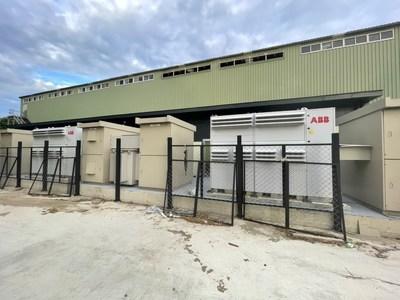The Italian solar inverter producer FIMER will energy Asia’s first automated frequency management initiative – Yahoo Finance
Bloomberg
The first warning sign in the global commodity boom is flashing in China
(Bloomberg) – One pillar of this year’s rapid commodities rally – Chinese demand – could fluctuate. Beijing was able to drive its economic recovery from the pandemic mainly through an expansion of credit and a state-sponsored construction boom that brought in raw materials across the planet. China was already the world’s largest consumer, spending $ 150 billion on crude oil, iron ore, and copper ore in the first four months of 2021 alone. The resurgent demand and soaring prices mean that’s $ 36 billion more than the same period last year Chinese government officials are trying to cut prices and cut some of the speculative foam that drives markets. The People’s Bank of China has also restricted the flow of money to the economy since last year so as not to affect growth. At the same time, the financing of infrastructure projects has slowed down. April economic data suggests that both China’s economic expansion and credit stimulus – new lending as a percentage of GDP – may have already peaked, which has culminated the rally on a precarious level. The most obvious effects of deleveraging in China would fall on the metals destined for real estate and infrastructure spending from copper and aluminum to steel and its main constituent iron ore. “Credit is a major driver of commodity prices and we expect prices to peak when credit peaks,” said Alison Li, co-director of base metals research at Mysteel in Shanghai. “That relates to global lending, but Chinese lending is a big part of that, especially when it comes to infrastructure and real estate investments.” However, the impact of China’s credit decline could have ramifications far and wide, and the rally in global oil prices is even threatening China’s harvest markets. And while the scarcity of money in recent weeks has not prevented many metals from reaching staggering levels, some, like copper, are already shying away consumers from higher prices. “The slowdown in lending will have a negative impact on China’s demand for raw materials,” said Hao Zhou, senior emerging markets economist at Commerzbank AG. “So far, real estate and infrastructure investments have shown no apparent slowdown. However, they should show a lower trend in the second half of the year. “A delay between the withdrawal of credit and stimulus measures and the impact on China’s commodity purchases could mean that markets have not yet peaked. However, companies could ultimately weaken imports due to tightened credit conditions, meaning the direction of the global commodity market will depend on how much recovery in economies, including the US and Europe, can continue to drive prices higher. Some sectors have seen a political boost in capacity expansion, such as Beijing’s move to expand the country’s crude oil refining and copper smelting industries. Purchases of materials needed for production in these sectors could continue to make gains, albeit at a slower pace. An example of a slowdown in purchases is likely to be refined copper, said Li of Mysteel. The premium paid for the metal in the port of Yangshan has already hit a four-year low, indicating declining demand, and imports are likely to decline this year, she said. At the same time, the rally in copper prices should still continue, according to a recent release from Citigroup Inc. citing the lag between peak credit and peak demand, there is still a few months to go. From currently around $ 9,850 per ton, the bank expects copper to hit $ 12,200 by September. This is a dynamic that is also noticeable in the ferrous metal markets. “We are still in the early stages of streamlining in raising funds for projects,” said Tomas Gutierrez, analyst at Kallanish Commodities Ltd. “The demand for iron ore reacts to a tightening with a delay of several months. Steel demand is still at record highs due to the economic recovery and ongoing investments, but is likely to decline slightly by the end of the year. “For agriculture, the credit crunch is likely to only marginally affect China’s rising crop imports,” said Ma Wenfeng, an analyst at Beijing Orient Agribusiness Consultant Co. Less cash in the system could lower domestic prices by curbing speculation, which in turn reduces the small share of cash private companies could reduce imports. The broader trend is towards the Chinese state giants, who continue to import grain to cover the country’s domestic deficit, replenish state reserves, and fulfill trade deals with the USNo disaster. In a broader sense, Beijing’s tightening of policy does not mean a catastrophe for commodity bulls. For one thing, the authorities are unlikely to accelerate deleveraging from this point on, according to the latest comments from the State Council’s Cabinet: “Our macro department’s internal guidelines are that the country will not tighten credit too much – they just won.” I’m not going to loosen up, ”said Harry Jiang, director of trade and research at Yonggang Resouces, a commodities trader in Shanghai. “We don’t have many concerns about the credit crunch.” In any case, the commodity markets are no longer almost entirely dependent on Chinese demand. “In the past, the turning point in industrial metals prices often coincides with China’s credit cycle,” said Larry Hu, chief economist for China at Macquarie Group Ltd. “Hu also noted the caution among China’s leaders who are unlikely to want to risk stifling their much-admired recovery with sharp political fluctuations.” I expect China’s real estate investment will slow, but not too much, “he said.” Infrastructure investment hasn’t changed too much in recent years and it won’t be this year. ” Consumer spending as a leverage for growth and is not as reliant on infrastructure and real estate investments Bruce Pang, head of macro and strategy research at China Renaissance Securities Hong Kong. The disruption of global raw material supplies due to the pandemic is also a new factor, Other political priorities include cutting steel production in order to improve China’s climate protection commitments, or increasing the supply of energy products domestically or through purchases from overseas, according to analysts, further complicating factors when assessing import demand and prices for certain goods lizes the copper price in paragraph 11.) More stories like this are available on bloomberg.com. Subscribe now to stay ahead of the curve with the most trusted business news source. © 2021 Bloomberg LP


Comments are closed.